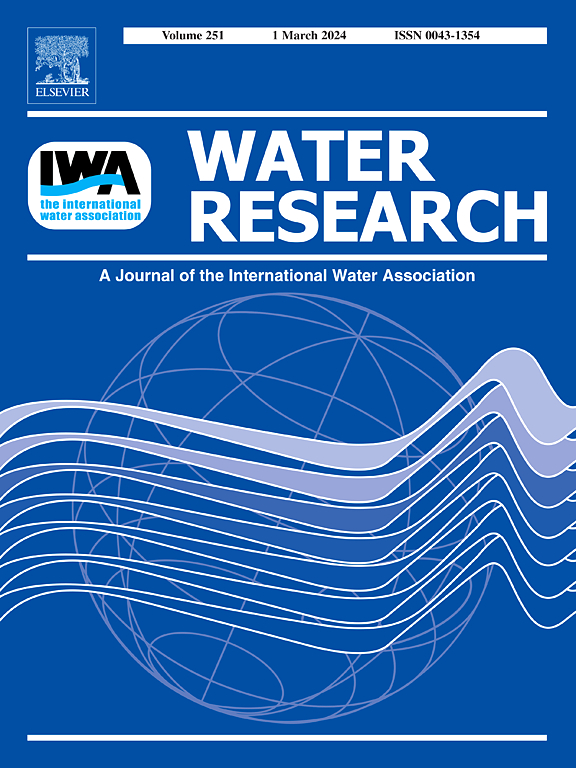Visible light-driven selective redirection of phenolic carbon in heterogeneous Fenton-like reaction
IF 12.4
1区 环境科学与生态学
Q1 ENGINEERING, ENVIRONMENTAL
引用次数: 0
Abstract
Oxidative polymerization of phenolic pollutants by the heterogeneous Fenton-like reaction is a sustainable strategy for wastewater decontamination and recovery of carbonaceous resources. However, controlling the reaction pathway to selectively polymerize the phenolic pollutants is challenging. Herein, we used visible light to shift the reaction pathway from phenolic pollutants degradation (which often results in incomplete mineralization) to polymerization over a g–C₃N₄ catalyst deposited on a Cu₂O nanowire. In peroxymonosulfate (PMS) activation, visible light illumination facilitates electron transfer from Cu₂O to g–C₃N₄, shifting the dominant reactive species on the Cu₂O surface from radical species to catalyst–PMS* complex. Experimental results and theoretical calculations verified the increased adsorption of PMS and the reduced energy barrier for phenol (PhOH) polymerization under visible light illumination. Compared to dark control conditions, visible light-assisted Fenton-like process resulted in a 9-fold faster PhOH oxidation (0.029 min⁻¹), significantly higher PMS utilization efficiency for total organic carbon removal, and enhanced robustness in real water matrices. This study provides fundamental insights into the regulation of reaction pathway over light-responsive semiconductor catalysts and highlights the potential for efficient treatment of phenolic water pollutants via oxidative polymerization.
非均相类芬顿反应中酚碳的可见光驱动选择性重定向
非均相类芬顿反应对酚类污染物的氧化聚合是一种可持续的废水净化和碳质资源回收策略。然而,控制反应途径以选择性聚合酚类污染物是具有挑战性的。在这里,我们使用可见光将反应途径从酚类污染物降解(通常导致不完全矿化)转变为沉积在Cu₂O纳米线上的g-C₃N₄催化剂上的聚合。在过氧单硫酸盐(PMS)活化中,可见光照明促进电子从Cu₂O转移到g-C₃N₄,将Cu₂O表面的主要反应物质从自由基转移到催化剂- PMS*络合物上。实验结果和理论计算验证了可见光照射下PMS的吸附增加和PhOH聚合的能垒降低。与黑暗对照条件相比,可见光辅助的Fenton-like工艺将phh氧化速度提高了9倍(0.029分钟),显著提高了PMS去除总有机碳的效率,并增强了在实际水基质中的鲁棒性。该研究为光响应半导体催化剂反应途径的调控提供了基础见解,并强调了通过氧化聚合有效处理酚类水污染物的潜力。
本文章由计算机程序翻译,如有差异,请以英文原文为准。
求助全文
约1分钟内获得全文
求助全文
来源期刊

Water Research
环境科学-工程:环境
CiteScore
20.80
自引率
9.40%
发文量
1307
审稿时长
38 days
期刊介绍:
Water Research, along with its open access companion journal Water Research X, serves as a platform for publishing original research papers covering various aspects of the science and technology related to the anthropogenic water cycle, water quality, and its management worldwide. The audience targeted by the journal comprises biologists, chemical engineers, chemists, civil engineers, environmental engineers, limnologists, and microbiologists. The scope of the journal include:
•Treatment processes for water and wastewaters (municipal, agricultural, industrial, and on-site treatment), including resource recovery and residuals management;
•Urban hydrology including sewer systems, stormwater management, and green infrastructure;
•Drinking water treatment and distribution;
•Potable and non-potable water reuse;
•Sanitation, public health, and risk assessment;
•Anaerobic digestion, solid and hazardous waste management, including source characterization and the effects and control of leachates and gaseous emissions;
•Contaminants (chemical, microbial, anthropogenic particles such as nanoparticles or microplastics) and related water quality sensing, monitoring, fate, and assessment;
•Anthropogenic impacts on inland, tidal, coastal and urban waters, focusing on surface and ground waters, and point and non-point sources of pollution;
•Environmental restoration, linked to surface water, groundwater and groundwater remediation;
•Analysis of the interfaces between sediments and water, and between water and atmosphere, focusing specifically on anthropogenic impacts;
•Mathematical modelling, systems analysis, machine learning, and beneficial use of big data related to the anthropogenic water cycle;
•Socio-economic, policy, and regulations studies.
 求助内容:
求助内容: 应助结果提醒方式:
应助结果提醒方式:


